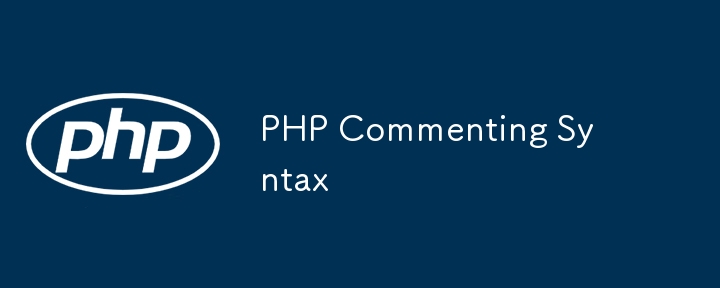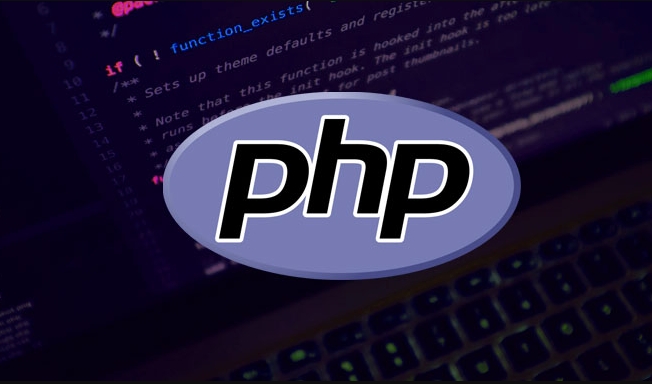PHP Commenting Syntax
There are three common ways to use PHP comments: single-line comments are suitable for briefly explaining code logic, such as // or # for the current line explanation; multi-line comments /*...*/ are suitable for detailed description of the role of functions or classes; document comments DocBlock start with /** to provide prompt information for the IDE. When using it, you should avoid nonsense, keep updating synchronously, and do not use comments to block codes for a long time.

Writing PHP comments is actually not difficult, but using them well can greatly improve the readability and maintenance of the code. Whether you look back on yourself or someone else takes over your code, clear comments can save you a lot of time.

Single-line comment: concisely explain the current logic
The most commonly used methods of single-line commenting in PHP are // and # . It is suitable to quickly explain the meaning next to a certain line of code, such as:
$counter = 0; // Initialize the counter
or:

$debugMode = true; # Used to enable debug output
This type of comment is suitable for writing shorter and does not need to be too complicated. Be careful not to pile too much, otherwise the code will appear messy.
Sometimes I will see developers put // in a separate line above the code to illustrate the role of the next paragraph of logic. This writing method is quite common and has good results.

Multi-line comment: Detailed description of the purpose of a function or class
If you need to write a more detailed explanation, such as explaining the function, parameter meaning or author information of a function, you have to use the form of /* ... */ :
/*
* Calculate total user points* Parameters:
* - $baseScore: Basic points* - $bonus: Extra points* The return value is integer type*/
function calculateTotalScore($baseScore, $bonus) {
return $baseScore $bonus;
}This method is more formal than single-line comments, and is suitable for putting it in front of function and class definitions to help others understand what this code is for. Some teams will also use it in conjunction with document generation tools, so the format is better if it is slightly standardized.
Document comments (DocBlock): Provide prompt information for the IDE
There is also a comment style called DocBlock in PHP, which starts with /** and is often used before classes, methods and attributes. The purpose is to identify IDE or document generation tools to improve the development experience:
/**
*User Model Class*
* Provide user-related operation methods*/
class User {
// ...
}Another example is a DocBlock of a method that might look like this:
/**
* Get the full name of the user*
* @return string User name combination*/
public function getFullName() {
return $this->first_name . ' ' . $this->last_name;
}The IDE will give automatic completion prompts based on these comments, which can also improve collaboration efficiency. Although it is not mandatory, it is indeed much more convenient to write it on.
Don't write comments randomly: Avoid misleading and redundant
There are a few things to note when writing comments:
- Don't write nonsense : For example,
// 设置用户名immediately followed by$user->setName("John");, such unnecessary comments will only make the code more messy. - Keep updating in sync : If the code is changed, the comments must also be changed. Otherwise, it will easily mislead people.
- Do not comment out the code block for too long : if it is temporarily blocked, it is OK; but if it is retained for a long time, it is recommended to delete it or use version control to manage it.
Basically that's it. The PHP comment syntax is not difficult, but how to use it clearly is the key.
The above is the detailed content of PHP Commenting Syntax. For more information, please follow other related articles on the PHP Chinese website!

Hot AI Tools

Undress AI Tool
Undress images for free

Undresser.AI Undress
AI-powered app for creating realistic nude photos

AI Clothes Remover
Online AI tool for removing clothes from photos.

Clothoff.io
AI clothes remover

Video Face Swap
Swap faces in any video effortlessly with our completely free AI face swap tool!

Hot Article

Hot Tools

Notepad++7.3.1
Easy-to-use and free code editor

SublimeText3 Chinese version
Chinese version, very easy to use

Zend Studio 13.0.1
Powerful PHP integrated development environment

Dreamweaver CS6
Visual web development tools

SublimeText3 Mac version
God-level code editing software (SublimeText3)

Hot Topics
 Tips for Writing PHP Comments
Jul 18, 2025 am 04:51 AM
Tips for Writing PHP Comments
Jul 18, 2025 am 04:51 AM
The key to writing PHP comments is to clarify the purpose and specifications. Comments should explain "why" rather than "what was done", avoiding redundancy or too simplicity. 1. Use a unified format, such as docblock (/*/) for class and method descriptions to improve readability and tool compatibility; 2. Emphasize the reasons behind the logic, such as why JS jumps need to be output manually; 3. Add an overview description before complex code, describe the process in steps, and help understand the overall idea; 4. Use TODO and FIXME rationally to mark to-do items and problems to facilitate subsequent tracking and collaboration. Good annotations can reduce communication costs and improve code maintenance efficiency.
 Improving Readability with Comments
Jul 18, 2025 am 04:46 AM
Improving Readability with Comments
Jul 18, 2025 am 04:46 AM
The key to writing good comments is to explain "why" rather than just "what was done" to improve the readability of the code. 1. Comments should explain logical reasons, such as considerations behind value selection or processing; 2. Use paragraph annotations for complex logic to summarize the overall idea of functions or algorithms; 3. Regularly maintain comments to ensure consistency with the code, avoid misleading, and delete outdated content if necessary; 4. Synchronously check comments when reviewing the code, and record public logic through documents to reduce the burden of code comments.
 Writing Effective PHP Comments
Jul 18, 2025 am 04:44 AM
Writing Effective PHP Comments
Jul 18, 2025 am 04:44 AM
Comments cannot be careless because they want to explain the reasons for the existence of the code rather than the functions, such as compatibility with old interfaces or third-party restrictions, otherwise people who read the code can only rely on guessing. The areas that must be commented include complex conditional judgments, special error handling logic, and temporary bypass restrictions. A more practical way to write comments is to select single-line comments or block comments based on the scene. Use document block comments to explain parameters and return values at the beginning of functions, classes, and files, and keep comments updated. For complex logic, you can add a line to the previous one to summarize the overall intention. At the same time, do not use comments to seal code, but use version control tools.
 PHP Commenting Syntax
Jul 18, 2025 am 04:56 AM
PHP Commenting Syntax
Jul 18, 2025 am 04:56 AM
There are three common ways to use PHP comments: single-line comments are suitable for briefly explaining code logic, such as // or # for the explanation of the current line; multi-line comments /*...*/ are suitable for detailed description of the functions or classes; document comments DocBlock start with /** to provide prompt information for the IDE. When using it, you should avoid nonsense, keep updating synchronously, and do not use comments to block codes for a long time.
 Effective PHP Commenting
Jul 18, 2025 am 04:33 AM
Effective PHP Commenting
Jul 18, 2025 am 04:33 AM
The key to writing PHP comments is clear, useful and concise. 1. Comments should explain the intention behind the code rather than just describing the code itself, such as explaining the logical purpose of complex conditional judgments; 2. Add comments to key scenarios such as magic values, old code compatibility, API interfaces, etc. to improve readability; 3. Avoid duplicate code content, keep it concise and specific, and use standard formats such as PHPDoc; 4. Comments should be updated synchronously with the code to ensure accuracy. Good comments should be thought from the perspective of others, reduce the cost of understanding, and become a code understanding navigation device.
 PHP Development Environment Setup
Jul 18, 2025 am 04:55 AM
PHP Development Environment Setup
Jul 18, 2025 am 04:55 AM
The first step is to select the integrated environment package XAMPP or MAMP to build a local server; the second step is to select the appropriate PHP version according to the project needs and configure multiple version switching; the third step is to select VSCode or PhpStorm as the editor and debug with Xdebug; in addition, you need to install Composer, PHP_CodeSniffer, PHPUnit and other tools to assist in development.
 PHP Comparison Operators
Jul 18, 2025 am 04:57 AM
PHP Comparison Operators
Jul 18, 2025 am 04:57 AM
PHP comparison operators need to pay attention to type conversion issues. 1. Use == to compare values only, and type conversion will be performed, such as 1=="1" is true; 2. Use === to require the same value as the type, such as 1==="1" is false; 3. Size comparison can be used on values and strings, such as "apple"
 PHP Comments for Teams
Jul 18, 2025 am 04:28 AM
PHP Comments for Teams
Jul 18, 2025 am 04:28 AM
The key to writing PHP comments is to explain "why" rather than "what to do", unify the team's annotation style, avoid duplicate code comments, and use TODO and FIXME tags reasonably. 1. Comments should focus on explaining the logical reasons behind the code, such as performance optimization, algorithm selection, etc.; 2. The team needs to unify the annotation specifications, such as //, single-line comments, function classes use docblock format, and include @author, @since and other tags; 3. Avoid meaningless annotations that only retell the content of the code, and should supplement the business meaning; 4. Use TODO and FIXME to mark to do things, and can cooperate with tool tracking to ensure that the annotations and code are updated synchronously and improve project maintenance.







